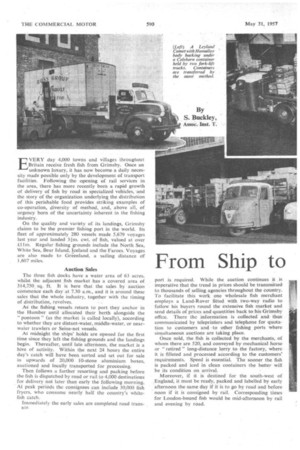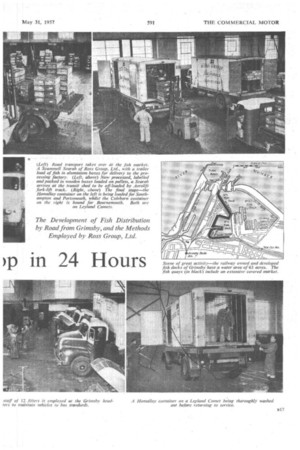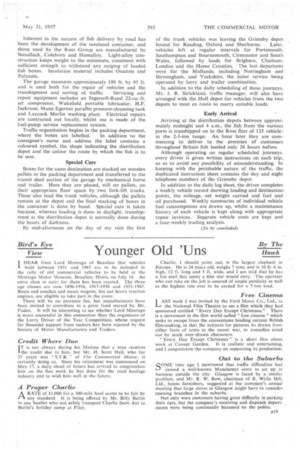From Ship to )p in 24 Hours
Page 50

Page 51

Page 52

Page 53

If you've noticed an error in this article please click here to report it so we can fix it.
The Development of Fish Distribution by Road from Grimsby, and the Methods Employed by Ross Group, Ltd.
EVERY day 4,000 towns and villages throughout Britain receive fresh fish from Grimsby. Once an unknown luxury, it has now become a daily necessity made possible only by the development of transport facilities. Following the opening of rail services in the area, there has more recently been a rapid growth of delivery of fish by road in specialized vehicles, and the story of the organization underlying the distribution of this perishable food provides striking examples of co-operation, diversity of method, and, above all, of urgency born of the uncertainty inherent in the fishing industry.
On the quality and variety of its landings, Grimsby claims to be the premier fishing port in the world. Its fleet of approximately 280 vessels made 5,679 voyages last year and landed 31m, cwt. of fish, valued at over £11m. Regular fishing grounds include the North Sea, White Sea, Bear Island, Iceland and the Faroes. Voyages are also made to Greenland, a sailing distance of 1,607 miles.
Auction Sales
The three fish docks have a water area of 63 acres, whilst the adjacent .fish market has a covered area of 314,750 sq. ft. It is here that the sales by auction commence each day at 7.30 a.m., and it is around these sales that the whole industry, together with the timing of distribution, revolves.
As the fishing vessels return to port they anchor in the Humber until allocated their berth alongside the " pontoon" (as the market is called locally), according to whether they are distant-water, middle-water, or nearwater trawlers or Seine-net vessels.
At midnight the ships' holds are opened for the first time since they left the fishing grounds and the landings begin. Thereafter, until late afternoon, the market is a hive of activity. Within the next 24 hours the entire day's catch will have been sorted and set out for sale in upwards of 20,000 10-stone aluminium boxes, auctioned and locally transported for processing.
Then follows a further resorting and packing before the fish is dispatched by road or rail to 4,000 destinations for delivery not later than early the following morning. At peak periods the consignees can include 30,000 fish fryers, who consume nearly half the country's whitefish catch.
Immediately the early sales are completed road trans port is required. While the auction continues it is imperative that the trend in prices should be transmitted to thousands of selling agencies throughout the country. To facilitate this work one wholesale fish merchant employs a Land-Rover fitted with two-way radio to follow his buyers round the extensive fish market and send details of prices and quantities back to his Grimsby office. There the information is collected and then communicated by teleprinters and telephone for quotation to customers •and to other fishing ports where simultaneous auctions are taking place.
Once sold, the fish is collected by the merchants, of whom there are 520, and conveyed by mechanical horse or " retired" long-distance lorry to the factory, where it is filleted and processed according to the customers' requirements. Speed is essential The sooner the fish is packed and iced in clean containers the better will be its condition on arrival.
Moreover, if it is destined for the south-west of England, it must be ready, packed and labelled by early afternoon the same day if it is to go by road and before noon if it is consigned by rail. Corresponding times for London-bound fish would be mid-afternoon by rail and evening by road. The additional time thereby made available before dispatch by -road is of especial advantage in these days of full employment. With labour less readily available, it is vital that more time be available for processing, if the quantity of fish handled is to be maintained or increased.
En route by road the fish is maintained in good condition by the use of insulated containers, whilst transhipment is reduced to a minimum and done only by staff who specialize in this class of traffic.
At the destination it is delivered to the customer, who is relieved of the cost and responsibility of either hiring transport or providing his own to collect his fish where rail delivery services are not available.
Although extremely competitive, the fishing industry practises co-operation wherever it is the more efficient method. This is exemplified in the trading companies of the Grimsby Trawler Owners' Association—the Grimsby Exchange, Ltd., and the Grimsby Salvage and Towing Co., Ltd.—both of whom are responsible for the provision of numerous port services.
Big Ice Factory Two examples will give some indication of the size of the ancillary trades. Situated at Grimsby is one of the world's largest ice factories, with a production capacity of 1,250 tons per day, whilst raw material used in the manufacture of fish meal on the Humber totals over 200,000 tons a year.
Diversity, however, is found in the method of road distribution adopted by the merchants or their associated transport companies. Larger concerns provide their own depots as the intermediate link between the port and the retailer, as opposed to the use of wholesalers. Superimposed on either system there may be transhipment points at which part loads from other ports, such as Hull or Fleetwood, are amalgamated before proceeding as full loads to their destination.
In addition to wet fish, road transport plays an important part in the distribution of cured and quickfrozen fish. The consumption of cured fish is heavy and increasing.
The full possibilities of the modern technique of quick freezing were not exploited until immediately after the last war. By partial neutralization of the daily and seasonal fluctuations in supply and demand for fish, its introduction and expansion have had repercussions on warehousing and distribution. Grimsby produces over half of this country's quick-frozen fish and contributes 53 per cent. of the quantity exported to 26 countries situated in every continent.
Better Service By Road
ONE of the larger organizations in the fishing
industry of Grimsby is. the Ross Group, Ltd., whose products are marketed under the trade name of Sea Sparkle. To expand the area of marketing and to provide a better service for increasing sales of quickfrozen fish, they began delivery by road in 1949:
Now 250 vehicles operate between the six coastal branches of Grimsby, Hull, Lowestoft, Fleetwood, Glasgow and Aberdeen, and the 33 sales and distribution depots stretching from North Shields to Bournemouth. As a result, fresh fish is now .being sold in villages and small towns where until recently it was not available.
Dependent on day-to-day landings and local prices, a balancing of supply and demand is made between the B 18 coastal branches, the fish being either road or railborne to exchange points.
The total fleet of 250 vehicles is distributed throughout the country and includes 50 heavies for use on trunk services. These are either Leyland Beavers or Comets, four Beavers and six Comets towing trailers as the occasion demands. For shorter deliveries 125 vehicles in the 2-ton and 3-ton class are operated and are of Austin, Bedford or Comtner manufacture. For local deliveries there are 57 Austin A30 and A40 vans and pick-ups, whilst for dock traffic between market, factory or transit shed 18 Scammell M.H.6 and Scarab mechanical horses are used.
As the headquarters of the transport organization, Grimsby is the base of 34 of the 50 trunk vehicles and 11 of the 18 mechanical horses.
Of a transport staff of 300, 12 fitters are employed at Grimsby and eight at Hull, where major repairs and accidents damage are dealt with for the whole fleet Mr. D. H. McVeigh, transport director, stressed that it was imperative that both men and vehicles should be absolutely reliable. Fish late was fish lost. Drivers were paid a bonus for freedom from accident every quarter and since its introduction delays causer) by accidents had been much reduced. A bonus of ES is also awarded each month to the driver of the best-kot mechanical horse, both in Grimsby and in Hull.
Vehicles are maintained to bus standards under the supervision of Mr. G. W. Keenleyside, group engineer, who has had passenger experience. Whatever a driver may report on his return to the depot, every vehicle is checked by fitters for roadworthiness after every trip. Engines are decarbonized at 50,000 miles, and at 100,000 miles, rings, pistons, big-end shells, valve springs and so on are replaced as required. At 200,000 miles the vehicle is stripped to the chassis members and rebuilt Dunlop and Goodyear tyres are used and are averaging 60,000 miles per set. Manufacturers' remoulds are also used, but are never fitted to the front wheels.
All bodies on the trunk vehicles are of Homalloy manufacture, specially made for the Ross Group. A drain channel is recessed behind the loading board, with drain tubes at each corner. A 50-gal. tank is fitted to the chassis, into which drains the waste water, so as to comply with the various by-laws prohibiting contamination of road surfaces by fish water. Inherent in the success of fish delivery by road has been the development of the insulated container, and those used by the Ross Group are manufactured by Bonallack, Coleborn and Homalloy. Light-alloy construction keeps weight to the minimum, consistent with sufficient strength to withstand any surging of loaded fish boxes. Insulation material includes Onazote and Polyzote.
The garage measures approximately 190 ft. by 95 ft. and is used both for the repair of vehicles and the transhipment and sorting of traffic. Servicing and repair equipment includes an Ingersoll-Rand 22-cu.-ft. air compressor, Wakefield portable lubricator, H.F. Iaekrane, Mann Egerton paraffin pressure-cleansing tank and Layeock Merlin washing plant. Electrical repairs are contracted out locally, whilst use is made of the fuel-pump service replacement system.
Traffic organization begins in the packing department, where the boxes are labelled. In addition to the consignee's name and address the label contains a coloured symbol, the shape indicating the distribution depot and the colour the route by which the fish is to be sent.
Special Care
Boxes for the same destination are stacked on wooden pallets in the packing department and transferred to the transit shed section of the garage by mechanical horse and trailer. Here they are placed, still on pallets, on their appropriate floor space by two fork-lift trucks. These also load the trunk vehicles, although the pallets remain at the depot and the final stacking of boxes in the container is done by hand. Special care is taken because, whereas loading is done in daylight, transhipment at the distribution depot is normally done during the hours of darkness, By mid-afternoon on the day of my visit the first of the trunk vehicles was leaving the Grimsby• depot bound for Reading, Oxford and Sherborne. Later, vehicles left at regular intervals for Portsmouth, Southampton and Bournemouth, Cirencester and South Wales, followed by loads for Brighton, Chatham, London and the Home Counties. The last departures were for the Midlands, including Nottingham and Birmingham, and Yorkshire, the latter service being operated by lorry and trader combination.
In addition to the daily scheduling of these journeys, Mr. J. R. Strickland, traffic manager, will also have arranged with the Hull depot for vehicles from the two depots to meet en route to marry suitable loads.
Early Arrival Arriving at the distribution depots between approximately midnight and 4 a.m., the fish from the various ports is transhipped on to the Ross fleet of 125 vehicle-; in the 2-3-ton range. An hour later they are commencing to deliver to the premises of customers throughout' Britain• fish landed only 24 hours before.
Although operating on regular scheduled journeys. every driver is given written instructions on each trip, so as to avoid any possibility of misunderstanding. In keeping with the perishable nature of the traffic, the duplicated instruction sheet contains the day and night telephone numbers of the Grimsby depot.
In addition to the daily log sheet, the driver completes a weekly vehicle record showing loading and destination, points, the mileage, net weight carried and fuel and oil purchased. Weekly summaries of individual vehicle fuel consumptions are drawn up, whilst a maintenance history of each vehicle is kept along with appropriate repair invoices. Separate vehicle costs are kept and a four-weekly trading analysis.
(To be concluded)




































































































